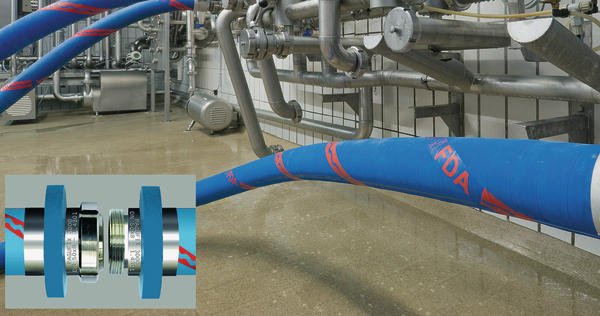Products for feeding and treating people must be kept as free from damaging influences as possible. However, safe products can only be manufactured using machines which can be cleaned reliably. This also applies to hose lines, a flexible system part used in many different applications.
According to the EU Machinery Directive, manufacturers of machines for the foodstuffs industry – and, since December 2009, manufacturers of machines for pharmaceutical production – must make their systems, units and components easy to clean and in such a way that risk to the end consumer is excluded, or at least reduced to an acceptable minimum. In order to guarantee this, Hubert Butterwegge, ContiTech AG’s Head of Sales for Industrial Hoses, recommends requesting written documentation of resistance to cleaning and disinfection agents from the hose line provider or supplier.
„What is useful is resistance tables which show basic cleaning agents like water, steam and sodium hydroxide, and also list various combination preparations.“ However, tables like this are only of help to users if they also contain information on how long the hose line can be subjected to the various agents as well as on maximum application temperatures and concentrations. In order to prevent the hose material from suffering damage, it is also important in this context to inform users that the concentration of many disinfection agents should only be as high as that recommended by the manufacturer when they are being used for extended disinfection over the week-end.
If the fittings are not properly connected to the hose, this can also lead to hygiene problems and hose failure. Due to the chemical cleaning processes, the safety regulations in the German Employment Accident Insurance Fund of the Chemical Industry (BG-Chemie) data sheet T002 „Hose lines – safe use“ (Schlauchleitungen – sicherer Einsatz) must be applied for hose lines used in the foodstuffs industry. This means that only press or clamp fittings are permitted for connecting the hoses, or vulcanised hose fittings in exceptional cases. Conventional hose fittings which have been used up until now, such as hose clamps, cable ties and even assembly wire are no longer permitted. Press and clamp fittings ensure a higher level of safety. Since the tightness of the connection between hose and fitting is higher than the bursting pressure of the hose, there is no chance of the fitting breaking off. Furthermore, the hose is prevented from thrashing uncontrollably when under pressure.
In addition to this, many of the older types of fitting and coupling systems carry severe hygiene risks. This is due to the fact that the hose nipple can become separated from the hose if the line becomes severely bent at the hose end, thus forming dead storage in which the medium can collect. In turn, this results in dirt cavities, which it may not be possible to adequately rinse and disinfect. With pressed fittings, no dead storage can form, especially if the outer sleeve of the fittings is longer than the internal support, as is the case for the Pagufix 3000 press fitting.
Adaptable to the application
The fitting system not only matches the requirements of the T002 data sheet for safe use of hose lines – the Pagufix 3000 press fitting also sets standards for quality and pressing technology. This high-quality press fitting is manufactured using the 1.4301 material as standard, but various special versions and other materials are also available. This means that the fitting can be adapted to perfectly suit any operational requirements. When used with the Lactopal or Lactopal L hoses, it provides the user with a safe and hygienic line.
Lactopal and the flexible Lactopal L are multi-purpose hoses for the foodstuffs, pharmaceutical and cosmetics industries which are particularly suited to transport-ing media containing grease and oil. Both hoses comply with the German Federal Institute for Risk Assessment (BfR) recommendation XXI and FDA requirements. In addition, its white, nonporous, smooth liner is resistant to conventional cleaning agents. It can also be sterilised with steam at temperatures of up to 110 °C, with peaks of up to 130 °C. The hose liner is extruded, not wound, as this would cause disadvantages. “Wound liners can come apart at the winding seams if subjected to mechanical influences or excessive heat, and this would cause a hygienic weak point,” warns ContiTech representative Butterwegge.
Online-Info www.cpp-net.com/2210470
Share:







